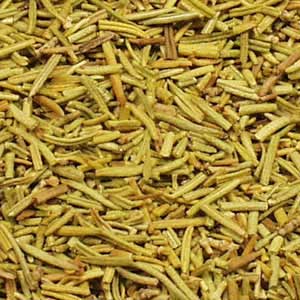 Subscribe to my feed for ingredients
Subscribe to my feed for ingredients  Add to My Yahoo
Add to My Yahoo 
© Copyright 1995-2023, Clay Irving <clay@panix.com>, Manhattan Beach, CA USA
 Subscribe to my feed for ingredients
Subscribe to my feed for ingredients  Add to My Yahoo
Add to My Yahoo
Rosemary Characteristics
Pronounced: 'rOz-"mer-E
Rosemary has a great tradition -- It has been used in cooking and medicine for almost 3,000 years. There are many stories, myths, and superstitions about rosemary. Traditionally, it is associated with memory and remembrance, and is a symbol for friendship and fidelity. It is used it to signify a special love or friendship and some countries continue to place a sprig of rosemary in the hands of the deceased before burial. Rosemary was thought to strengthen the brain, and Greek students would often wear rosemary garlands or braid rosemary into their hair to help them in their exams. Rosemary was once thought to ward off evil spririts. During the Middle Ages people slept with rosemary branches under their pillows to keep them safe from demons and nightmares. Demons can take many forms such as unpleasant odors, witchcraft and the Plague -- rosemary has been burned or ingested or carried to prevent them all. The Romans often burned as incense during weddings, funerals and other church activities.
Rosemary is a spikey evergreen bush with needle-shaped leaves similar to a pine tree. It is a member of the mint family, and botanically is known as Rosmarinus officinalis. Rosemary is a versatile, aromatic herb. It is used in a wide variety of dishes, including fruit salads, soups, vegetables, meats (especially lamb), fish, eggs, stuffings, dressings and even desserts. It is also used to scent cosmetics and perfumes, in insect repellants, and has medicinal uses.
Around the world, rosemary is also called rosemarin, romero, romarin, rosemarino, mi tieh hsiang, rozmarin, and alecrim. The peppery pine tree smell of rosemary may smell familiar to you because the oils are widely used in toiletries. In fact, rosemary was one of the first essential oils to be distilled. Raymudus Lullus developed a method for vaporization and condensation in 1330.
Fresh rosemary sprigs are used in cooking by stripping the "pine needle" leaves from the main branch. It combines well with other spices, but does have a tendency to dominate because it does not lose its flavor during a long cooking process. Dried rosemary in the whole leaf or ground form is also used in cooking. Use your fingers or a knife to break up the dried leaves before adding to a recipe. Ground rosemary will lose potency quickly, as with all ground seasoning, but is nice if you don't want the bits of tough herb in the final product. To dry your own, simply hang a bundle of freshly-clipped four-inch sprigs upside down until thoroughly dried.
Store fresh rosemary in a plastic bag or in a glass of water in the refrigerator. To dry your own rosemary, hang fresh sprigs in a warm, dry place. Be sure to strip off the leaves before storing. This is easily done after the sprigs are dry by putting them in a plastic bag and rubbing them off the stem. Store in an airtight container, in a cool, dry place, away from light, to preserve freshness and flavor.
Varieties


|